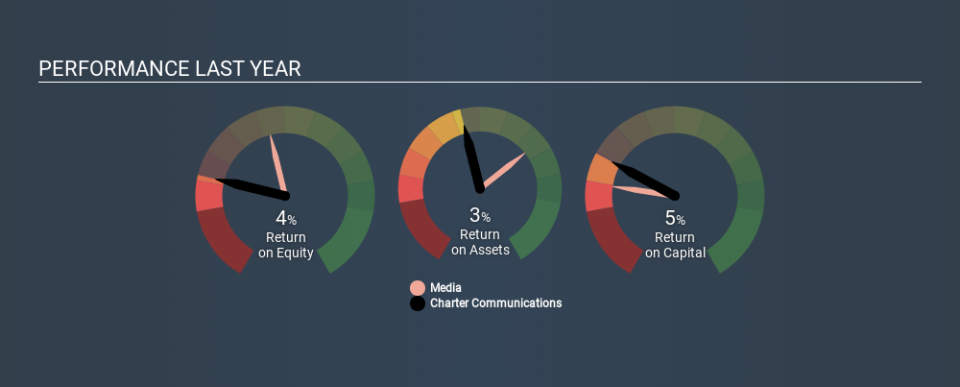Why We’re Not Keen On Charter Communications, Inc.’s (NASDAQ:CHTR) 4.6% Return On Capital

Today we are going to look at Charter Communications, Inc. (NASDAQ:CHTR) to see whether it might be an attractive investment prospect. To be precise, we'll consider its Return On Capital Employed (ROCE), as that will inform our view of the quality of the business.
First of all, we'll work out how to calculate ROCE. Next, we'll compare it to others in its industry. Last but not least, we'll look at what impact its current liabilities have on its ROCE.
Return On Capital Employed (ROCE): What is it?
ROCE measures the amount of pre-tax profits a company can generate from the capital employed in its business. All else being equal, a better business will have a higher ROCE. In brief, it is a useful tool, but it is not without drawbacks. Renowned investment researcher Michael Mauboussin has suggested that a high ROCE can indicate that 'one dollar invested in the company generates value of more than one dollar'.
So, How Do We Calculate ROCE?
Analysts use this formula to calculate return on capital employed:
Return on Capital Employed = Earnings Before Interest and Tax (EBIT) ÷ (Total Assets - Current Liabilities)
Or for Charter Communications:
0.046 = US$6.2b ÷ (US$145b - US$12b) (Based on the trailing twelve months to September 2019.)
So, Charter Communications has an ROCE of 4.6%.
Check out our latest analysis for Charter Communications
Does Charter Communications Have A Good ROCE?
When making comparisons between similar businesses, investors may find ROCE useful. In this analysis, Charter Communications's ROCE appears meaningfully below the 9.1% average reported by the Media industry. This could be seen as a negative, as it suggests some competitors may be employing their capital more efficiently. Regardless of how Charter Communications stacks up against its industry, its ROCE in absolute terms is quite low (especially compared to a bank account). Readers may wish to look for more rewarding investments.
Our data shows that Charter Communications currently has an ROCE of 4.6%, compared to its ROCE of 2.2% 3 years ago. This makes us wonder if the company is improving. The image below shows how Charter Communications's ROCE compares to its industry, and you can click it to see more detail on its past growth.
When considering ROCE, bear in mind that it reflects the past and does not necessarily predict the future. ROCE can be misleading for companies in cyclical industries, with returns looking impressive during the boom times, but very weak during the busts. ROCE is only a point-in-time measure. Future performance is what matters, and you can see analyst predictions in our free report on analyst forecasts for the company.
How Charter Communications's Current Liabilities Impact Its ROCE
Current liabilities are short term bills and invoices that need to be paid in 12 months or less. The ROCE equation subtracts current liabilities from capital employed, so a company with a lot of current liabilities appears to have less capital employed, and a higher ROCE than otherwise. To counter this, investors can check if a company has high current liabilities relative to total assets.
Charter Communications has total assets of US$145b and current liabilities of US$12b. As a result, its current liabilities are equal to approximately 8.2% of its total assets. Charter Communications has a low level of current liabilities, which have a negligible impact on its already low ROCE.
Our Take On Charter Communications's ROCE
Nevertheless, there are potentially more attractive companies to invest in. You might be able to find a better investment than Charter Communications. If you want a selection of possible winners, check out this free list of interesting companies that trade on a P/E below 20 (but have proven they can grow earnings).
If you are like me, then you will not want to miss this free list of growing companies that insiders are buying.
If you spot an error that warrants correction, please contact the editor at editorial-team@simplywallst.com. This article by Simply Wall St is general in nature. It does not constitute a recommendation to buy or sell any stock, and does not take account of your objectives, or your financial situation. Simply Wall St has no position in the stocks mentioned.
We aim to bring you long-term focused research analysis driven by fundamental data. Note that our analysis may not factor in the latest price-sensitive company announcements or qualitative material. Thank you for reading.

 Yahoo Finance
Yahoo Finance 
